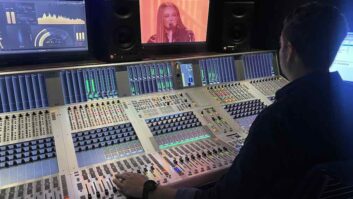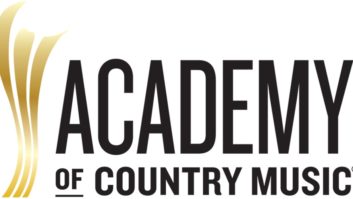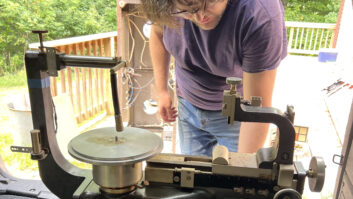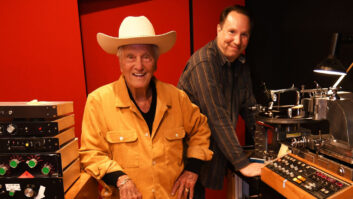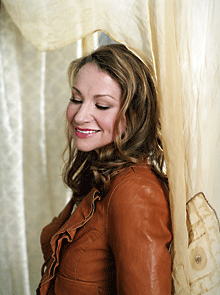
It should come as no surprise that Joan Osborne wanted to make a country album. Born and raised in Kentucky, Osborne is a longtime, die-hard fan of the genre and can apply her vocal talent to literally any style, from rock to soul to blues to country and even the musical melting pot of The Dead.
Pretty Little Stranger, Osborne’s first project for Vanguard Records, comprises 12 tracks: six originals and the rest written by such artists as Patty Griffin, Rodney Crowell, Jerry Garcia and Robert Hunter, and Kris Kristofferson. It was recorded in Nashville with producer Steve Buckingham and engineer Neal Cappellino. Buckingham is a four-time Grammy winner with 27 Number One singles and at least 150 albums to his credit. He was VP of A&R for Columbia Records for 10 years and is now senior VP of Vanguard and Sugar Hill Records. Cappellino, who this year won a Grammy for his work with Del McCoury (Best Bluegrass Album, The Company We Keep), has recorded for years with Buckingham and producer Gary Paczosa as their assistant engineer and Pro Tools expert. He engineered Pretty Little Stranger while Paczosa and Alison Krauss were working on Alan Jackson’s latest release, Like Red on a Rose. (See “Recording Notes: Country Royalty” in the November 2006 issue.)
Buckingham’s introduction to Osborne was her appearance in the documentary Standing in the Shadows of Motown (2002). Watching it in a Nashville movie theater with friends, he recalls, “Joan came on and sang the old Jimmy Ruffin tune ‘What Becomes of the Brokenhearted,’” Buckingham remembers. “We’d all heard of her, but we had no idea she had those pipes. She was the highlight of the movie.
“I was putting together a Dolly Parton tribute album. I wanted to get Joan on it and she agreed. John Leventhal did her track ‘Do I Ever Cross Your Mind,’ and it put Dolly and me on the floor; we loved it. So I started e-mailing Joan about doing a roots-type album, and it took two years to get around to doing this.”
Buckingham’s key players on the album were drummer Eddie Bayers, bassist Michael Rhodes, and guitarists Steve Gibson (electric) and Bryan Sutton (acoustic). Recording with Osborne, he says, “was magic. There were tears in the studio. It was emotional for everyone. Of all the artists I’ve worked with, Joan is in the top five. Her live vocals were astonishing, yet she kind of shrugs it off, like Dolly does.”
Pretty Little Stranger was Cappellino’s first time working with the vocalist and, he says, “It was definitely a ‘pinch me’ experience since I’ve been wearing out her records from Relish to Righteous Love to How Sweet It Is for years, and always thought of her as a pinnacle artist. When Steve told me he had been talking to her about doing a record, I just about busted. I remember thinking, ‘I’ve got to work on this project.’ I was absolutely emphatic about it when I talked to him.”
Pretty Little Stranger was cut at Omni Studios (Nashville). “I went in with the assistant, Bob Ingison, the day before the session to load in gear and get set up, work out bugs,” says Cappellino. “We just got it ready to roll as much as possible so we could hit the ground running when everyone came in. One thing I did that I haven’t done before is check the phase of the cue system to make sure it corresponded to what was happening acoustically in the room. This may seem mundane, but what is right in the control room may not be in phase with the headphone mix everyone’s getting. I wanted to make sure the headphones sounded great, and I’m especially keen on making drummers happy. Everything at Omni was rock-solid, not a single glitch, and you couldn’t ask for a more competent assistant than master Bob.”
Equally impressive is the clarity of Osborne’s vocals, with every nuance out front. “It’s worth noticing that this record is different from her other records that are more rock/R&B-infused,” says Cappellino. “I knew that the tracks would be more sparse and minimal, and that would require or accommodate a different vocal approach. So first and foremost, I think the arrangements allow the vocal to be what it is. We used quite a bit of her tracking vocals on many songs, and on at least one song she nailed it with the band. It was an impressive example of what a great vocalist can do to inspire a performance from a band in the studio. She was always on; there’s no other position for the switch. Anytime she’s singing, it’s for real.
“We did a mic shoot-out with five or six different mics, and I had prepared some tracks off of Joan’s previous albums for her to sing to,” Cappellino continues. “We all agreed on the mic selection, and during tracking I auditioned a couple of preamps and settled on the Mastering Lab. In the mix stage, instead of heavy compression to control levels, I did loads of rides in Pro Tools and a fair amount on the console, too. The volume automation on the screen starts looking like a lie-detector graph, but adjusting in Pro Tools allows me to really dig in for things. It also affects how the signal hits the outboard processing, and if I feel like it’s in the sweet spot there, I can grab a fader on the console. More often than not, I’ll be doing manual de-essing, too.”
Buckingham’s production style is directorial in its approach. “I have studied how old [film] directors put together an atmosphere where people are free to create,” he says. “That’s what I try to do. There’s no set way I do it for each artist, but that’s the overall way I look at it. I have arrangements together by the time we go in, the number charts are sketched out. It’s not left up to chance. With Joan, we worked very fast. Nothing needed more than three takes.”
“One of Steve’s strong points as a producer is the way he casts characters for a project,” adds Cappellino. “There’s a specific reason for every one of us being there, and that results in a lot of unspoken common ground. We’re all on the same page walking in the door, and you’re there to do exactly what it is you love to do. As an engineer — and I imagine for the musicians especially — that breeds confidence and cohesion.
“I think a good producer/engineer combination also includes some degree of overlap between the two roles — an engineer who can comprehend music and a producer who understands the technical process,” he continues. “Although this is the first album I’ve been in a mixing role with Steve, we’ve worked together on a number of projects over the last six years, so there’s a trust and mutual respect for each other’s talents. In addition to the engineering responsibilities, I see myself in a support role to the producer and that means striking a good balance of when to speak up unsolicited and when to keep my mouth shut. But if Steve asks for my input, I want to make sure I have something to offer. On Joan’s project, whether it was me asking for input on a mix or Steve asking for an opinion on a take, we seemed to confirm each other’s suspicion more often than not. Most importantly, there are no egos and it’s understood that everyone is trying to serve the music.”
Osborne’s vocals were tracked on a Neumann M49, which Cappellino says is probably a 1950s vintage and came from Blackbird Rentals (Nashville). As for the rest of his arsenal, “The list is growing,” he says, “but I’m always checking out different pieces and seeing just what I end up reaching for most often. More recently, this has included ribbon mics. I’ve probably been slow to the table with ribbons for whatever reason, but a lot of times, they’re the sound I’m looking for. Daking and API preamps are pieces I’ll almost always use. In the digital domain, if we’re in that world, I like using [Audio Ease] Altiverb, [Digidesign] ReVibe and the new TC Electronic 6000 plug-ins for effects. They sound great, [are] easy to recall and I can bus to them internally from the console or both.”
During the past few years, Osborne has become more relaxed as a singer and a performer. “I tended to overpower the material because I have such a strong voice,” she says. “As a performer, I have a lot of passion that I bring to what I do, and maybe it was overdone. As a songwriter, I’m always exploring and challenging myself to express things more simply. I find satisfaction in that.
“Classic country songs use very simple, direct language to describe universal experiences so that anyone can understand,” she continues. “My writing in the past was abstract, and it was a challenge to say what I meant and to be poetic in a simple way. I haven’t mastered it yet; I’m still trying. Now that I’ve managed to write in a simpler style, it will be interesting to try to keep one foot in each area and see if it ends up in the middle or some of both. I feel that both are effective and can be very beautiful, and now that I’ve discovered a new way of working, I don’t want to abandon it.”

